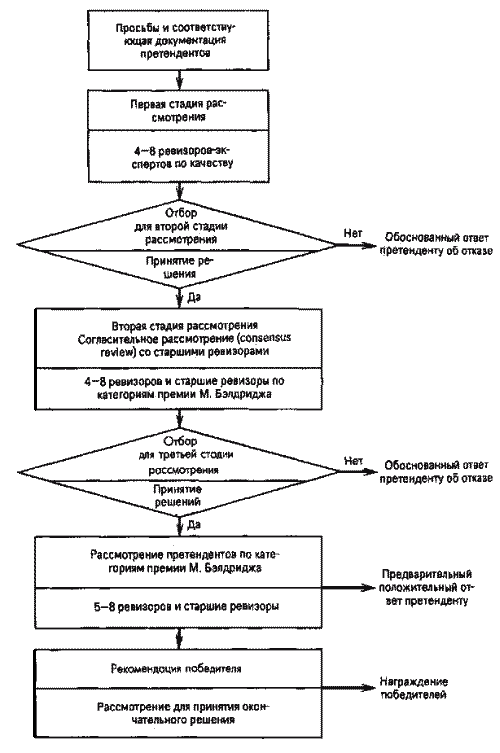Реферат: Премии качества
-здравоохранение.
Премия М. Бэлдриджа присуждается не более чем двум компаниям в каждой категории. Национальная премия М. Бэлдриджа была инспирирована DAP (призом Деминга), и поэтому требования этих двух премий близки, например в части критериев, оценивающих работу претендента. Однако критерии премии М. Бэлдриджа более детализированы, чем критерии приза Деминга, а системы оценки претендентов различны.
Просьба (заявление) компании, претендующей на премию М. Бэлдриджа, рассматривается группой людей из Совета ревизоров (экзаменаторов — examiners board), состоящего примерно из 150 .экспертов по качеству, представляющих промышленность, правительство и университеты. Процедура рассмотрения претендентов, считающих себя достойными получить национальную премию М. Бэлдриджа, приведена на рис.2.

Рис. 2. Процедура оценки претендентов на национальную премию М. Бэлдриджа
От компаний, претендующих на премию, требуется представить документацию на свою Систему Качества. Компании, прошедшие первую стадию рассмотрения, подлежат более тщательному рассмотрению на последующих стадиях.
Анализ претендентов на премию М. Бэлдриджа проводится в соответствии со следующими семью критериями. Для каждого критерия в скобках приводится его вес в процентах (данные на 1994 г.). (критерии образца 2001 года можно посмотреть по адресу: http://www.quality.nist.gov)
The Malcolm Baldrige National Quality Improvement Act of 1987 - Public Law 100-107
The Malcolm Baldrige National Quality Award was created by Public Law 100-107, signed into law on August 20, 1987. The Award Program, responsive to the purposes of Public Law 100-107, led to the creation of a new public-private partnership. Principal support for the program comes from the Foundation for the Malcolm Baldrige National Quality Award, established in 1988.
The Award is named for Malcolm Baldrige, who served as Secretary of Commerce from 1981 until his tragic death in a rodeo accident in 1987. His managerial excellence contributed to long-term improvement in efficiency and effectiveness of government. The Findings and Purposes Section of Public Law 100-107 states that:"
| 1. | the leadership of the United States in product and process quality has been challenged strongly (and sometimes successfully) by foreign competition, and our Nation's productivity growth has improved less than our competitors' over the last two decades. |
| 2. | American business and industry are beginning to understand that poor quality costs companies as much as 20 percent of sales revenues nationally and that improved quality of goods and services goes hand in hand with improved productivity, lower costs, and increased profitability. |
| 3. | strategic planning for quality and quality improvement programs, through a commitment to excellence in manufacturing and services, are becoming more and more essential to the well-being of our Nation's economy and our ability to compete effectively in the global marketplace. |
| 4. | improved management understanding of the factory floor, worker involvement in quality, and greater emphasis on statistical process control can lead to dramatic improvements in the cost and quality of manufactured products. |
| 5. | the concept of quality improvement is directly applicable to small companies as well as large, to service industries as well as manufacturing, and to the public sector as well as private enterprise. |
| 6. | in order to be successful, quality improvement programs must be management-led and customer-oriented, and this may require fundamental changes in the way companies and agencies do business. |
| 7. | several major industrial nations have successfully coupled rigorous private-sector quality audits with national awards giving special recognition to those enterprises the audits identify as the very best; and |
| 8. | a national quality award program of this kind in the United States would help improve quality and productivity by: |
| a. | helping to stimulate American companies to improve quality and productivity for the pride of recognition while obtaining a competitive edge through increased profits; |
| b. | recognizing the achievements of those companies that improve the quality of their goods and services and providing an example to others; |
| c. | establishing guidelines and criteria that can be used by business, industrial, governmental, and other organizations in evaluating their own quality improvement efforts; and |
| d. | providing specific guidance for other American organizations that wish to learn how to manage for high quality by making available detailed information on how winning organizations were able to change their cultures and achieve eminence." |
|